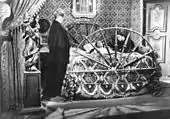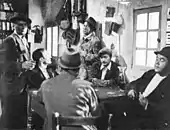Calligrafismo
Calligrafismo (En: caligraphism) is an Italian style of filmmaking in the first half of the 1940s.
Characteristics of the style

A scene from La bella addormantata (1942)
In the 1940s the two most significant styles of the Italian movie scene were the telefoni bianchi (En: white telephones) and calligrafismo.
Calligrafismo is in a sharp contrast to telefoni bianchi-American style comedies and is rather artistic, highly formalistic, expressive in complexity and deals mainly with contemporary literary material,[1] above all the pieces of Italian realism from authors like Corrado Alvaro, Ennio Flaiano, Emilio Cecchi, Francesco Pasinetti, Vitaliano Brancati, Mario Bonfantini and Umberto Barbaro.[2]
The most important directors and scriptwriters

Scene from Tragica notte (1942)
Scriptwriters
- Virgilio Marchi
- Gino Carlo Sensani
- Antonio Valente.
References
Sources
- Roberto Campari, Il fantasma del bello. Iconologia del cinema italiano, Marsilio, Venezia, 1994. ISBN 88-317-5898-5
- ISBN 88-317-5774-1
- Lontani dalla gloria (Narrativa) (Italian Edition)
- After Neorealism: Italian Filmmakers and Their Films; Essays and Interviews
This article is issued from Wikipedia. The text is licensed under Creative Commons - Attribution - Sharealike. Additional terms may apply for the media files.